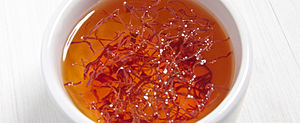Use of saffron
Use of Saffron[edit | edit source]
Saffron is a highly prized spice derived from the flower of Crocus sativus, commonly known as the "saffron crocus". The vivid crimson stigmas and styles, called threads, are collected and dried to be used mainly as a seasoning and coloring agent in food. Saffron is the most expensive spice by weight due to the labor-intensive process of harvesting it. This article explores the various uses of saffron in culinary traditions, its cultural significance, and its applications beyond the kitchen.
Culinary Uses[edit | edit source]
Saffron is renowned for its ability to impart a rich golden-yellow hue and a distinct aroma to dishes. It is a staple in many cuisines around the world.
European Cuisine[edit | edit source]
In Spain, saffron is a key ingredient in paella, a traditional rice dish that combines seafood, chicken, and vegetables. The spice not only adds color but also a subtle flavor that complements the other ingredients.
In Sweden, saffron is used in baking, particularly in the preparation of saffron buns (lussekatter), which are traditionally served during the Saint Lucy's Day celebrations.
Middle Eastern Cuisine[edit | edit source]
Saffron is a quintessential component of many Middle Eastern dishes. In Iran, it is used in a variety of rice dishes, such as chelow and tahdig, where it imparts a unique flavor and color.
Indian Cuisine[edit | edit source]
In India, saffron is used in both sweet and savory dishes. It is a key ingredient in biryani, a fragrant rice dish, and in desserts like kheer and gulab jamun. Saffron is also used to flavor and color ladoo and halwa.
Cultural and Religious Significance[edit | edit source]
Saffron holds significant cultural and religious importance in various traditions. In Buddhism, saffron-colored robes are worn by monks, symbolizing simplicity and detachment from materialism.
In Hinduism, saffron is considered sacred and is used in religious rituals and ceremonies. It is often used to mark the forehead of deities and devotees.
Medicinal Uses[edit | edit source]
Saffron has been used in traditional medicine for centuries. It is believed to have various health benefits, including improving mood, enhancing memory, and possessing antioxidant properties. In Ayurveda, saffron is used to treat a variety of ailments, from digestive issues to skin conditions.
Related Pages[edit | edit source]
Search WikiMD
Ad.Tired of being Overweight? Try W8MD's physician weight loss program.
Semaglutide (Ozempic / Wegovy and Tirzepatide (Mounjaro / Zepbound) available.
Advertise on WikiMD
|
WikiMD's Wellness Encyclopedia |
| Let Food Be Thy Medicine Medicine Thy Food - Hippocrates |
Translate this page: - East Asian
中文,
日本,
한국어,
South Asian
हिन्दी,
தமிழ்,
తెలుగు,
Urdu,
ಕನ್ನಡ,
Southeast Asian
Indonesian,
Vietnamese,
Thai,
မြန်မာဘာသာ,
বাংলা
European
español,
Deutsch,
français,
Greek,
português do Brasil,
polski,
română,
русский,
Nederlands,
norsk,
svenska,
suomi,
Italian
Middle Eastern & African
عربى,
Turkish,
Persian,
Hebrew,
Afrikaans,
isiZulu,
Kiswahili,
Other
Bulgarian,
Hungarian,
Czech,
Swedish,
മലയാളം,
मराठी,
ਪੰਜਾਬੀ,
ગુજરાતી,
Portuguese,
Ukrainian
Medical Disclaimer: WikiMD is not a substitute for professional medical advice. The information on WikiMD is provided as an information resource only, may be incorrect, outdated or misleading, and is not to be used or relied on for any diagnostic or treatment purposes. Please consult your health care provider before making any healthcare decisions or for guidance about a specific medical condition. WikiMD expressly disclaims responsibility, and shall have no liability, for any damages, loss, injury, or liability whatsoever suffered as a result of your reliance on the information contained in this site. By visiting this site you agree to the foregoing terms and conditions, which may from time to time be changed or supplemented by WikiMD. If you do not agree to the foregoing terms and conditions, you should not enter or use this site. See full disclaimer.
Credits:Most images are courtesy of Wikimedia commons, and templates, categories Wikipedia, licensed under CC BY SA or similar.
Contributors: Prab R. Tumpati, MD





